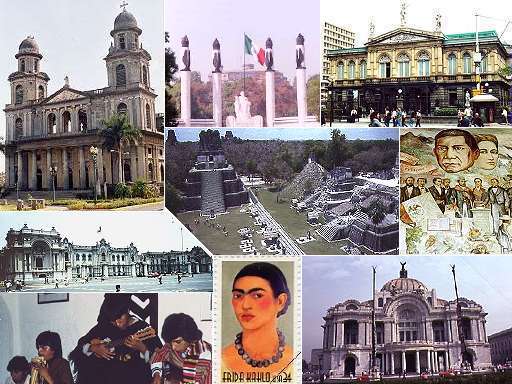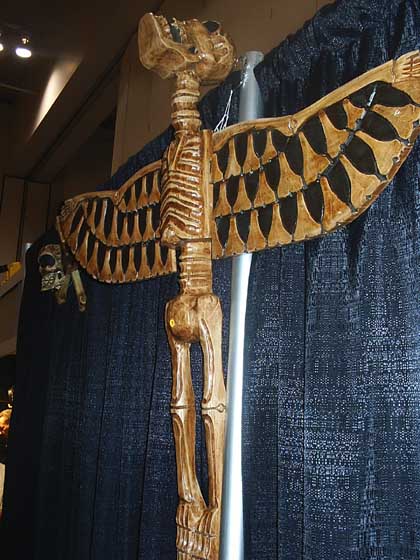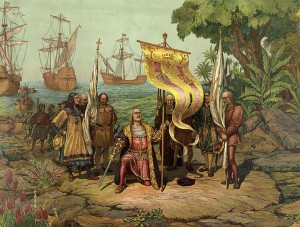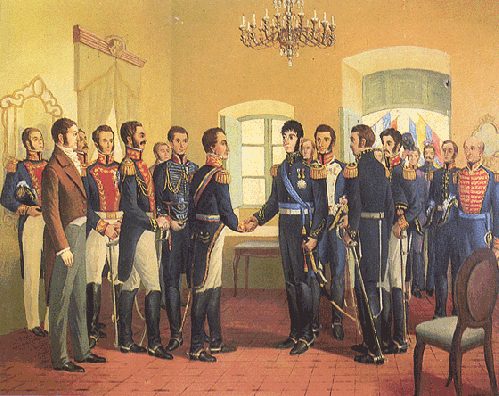Pre-columbian history
The Americas were thought to have been first inhabited by people crossing the Bering Land Bridge , now known as the Bering strait , from northeast Asia into Alaska well over 10,000 years ago. The earliest known settlement, however, was identified at Monte Verde, near Puerto Montt in Southern Chile. Its occupation dates to some 14,000 years ago and there is some disputed evidence of even earlier occupation. Over the course of millennia, people spread to all parts of the continents. By the first millennium AD / CE , South America's vast rainforests, mountains, plains and coasts were the home of tens of millions of people. The earliest settlements in the Americas are of the Las Vegas Culture from about 8000 BC and 4600 BC, a sedentary group from the coast of Ecuador , the forefathers of the more known Valdivia culture , of the same era. Some groups formed more permanent settlements such as the Chibchas (or "Muiscas" or "Muyscas") and the Tairona groups. These groups are in the circum Caribbean region. The Chibchas of Colombia , the Quechuas and Aymaras of Bolivia and Perú were the three Indian groups that settled most permanently.A view of Machu Picchu , a pre-Columbian Inca site in Peru . One of the New Seven Wonders of the World .
The region was home to many indigenous peoples and advanced civilizations, including the Aztecs , Toltecs , Caribs , Tupi , Maya , and Inca . The golden age of the Maya began about 250, with the last two great civilizations , the Aztecs and Incas, emerging into prominence later on in the early fourteenth century and mid-fifteenth centuries, respectively. The Aztec empire was ultimately the most powerful civilization known throughout the Americas, until its downfall in part by the Spanish invasion.
European colonization
With the arrival of the Europeans following Christopher Columbus 's voyages, the indigenous elites, such as the Incas and Aztecs, lost power to the heavy European invasion. Hernándo Cortés seized the Aztec elite's power with the help of local groups who did not favor the Aztec elite, and Francisco Pizarro eliminated the Incan rule in Western South America. The European powers of Spain and Portugal colonized the region, which along with the rest of the uncolonized world, was divided into areas of Spanish and Portuguese control by the line of demarcation in 1493, which gave Spain all areas to the west, and Portugal all areas to the east (the Portuguese lands in South America subsequently becoming Brazil). By the end of the sixteenth century Spain and Portugal had been joined by others, including France, in occupying large areas of North, Central and South America, ultimately extending from Alaska to the southern tips of the Patagonia . European culture, customs and government were introduced, with the Roman Catholic Church becoming the major economic and political power to overrule the traditional ways of the region, eventually becoming the only official religion of the Americas during this period.
Epidemics of diseases brought by the Europeans, such as smallpox and measles , wiped out a large portion of the indigenous population. Historians cannot determine the number of natives who died due to European diseases, but some put the figures as high as 85% and as low as 25%. Due to the lack of written records, specific numbers are hard to verify. Many of the survivors were forced to work in European plantations and mines. Intermixing between the indigenous peoples and the European colonists was very common, and, by the end of the colonial period , people of mixed ancestry ( mestizos ) formed majorities in several colonies.
Independence (1804–1825)
Simón Bolívar, one of the main Independence movement leadersHaiti, sometimes counted among the Latin American nations, was the first to gain independence, in 1804. This followed from a violent slave revolt led by Toussaint L'ouverture on the French colony of Saint-Domingue . The victors abolished slavery. Haitian independence helped inspire independence movements in Spanish America.
By the end of the eighteenth century, Spanish and Portuguese power waned on the global scene as other European powers took their place, notably Britain and France. Resentment grew among the majority of the population in Latin America over the restrictions imposed by the Spanish government, as well as the dominance of native Spaniards (Iberian-born Peninsulares ) in the major social and political institutions . Napoleon 's invasion of Spain in 1808 marked a turning point, compelling Criollo elites to form juntas that advocated independence. Also, the newly independent Haiti , the second oldest nation in the New World after the United States and the oldest independent nation in Latin America, further fueled the independence movement by inspiring the leaders of the movement, such as Simón Bolívar and José de San Martín , and by providing them with considerable munitions and troops.
Fighting soon broke out between juntas and the Spanish colonial authorities, with initial victories for the advocates of independence. Eventually these early movements were crushed by the royalist troops by 1812, including those of Miguel Hidalgo y Costilla in Mexico and Francisco de Miranda in Venezuela . Under the leadership of a new generation of leaders, such as Simón Bolívar of Venezuela, José de San Martín of Argentina, and other Libertadores in South America, the independence movement regained strength, and by 1825, all Spanish America , except for Puerto Rico and Cuba, had gained independence from Spain. Brazil achieved independence with a constitutional monarchy established in 1822. In the same year in Mexico , a military officer, Agustín de Iturbide , led a coalition of conservatives and liberals who created a constitutional monarchy , with Iturbide as emperor . This First Mexican Empire was short-lived, and was followed by the creation of a republic in 1823.
Cold War and military dictatorships (1946–1990)
In the 1950s, the Cold War moved close to the United States , in Latin America. The nations of Latin America faced many critical problems, including widespread poverty and poor health care. The United States feared the politics of socialism and communism would be particularly appealing to the countries of Latin America. At the same time, many United States citizens worried about the threat to their own security and businesses in Latin America. This led the United States to take up a very aggressive military strategy of containment . Through the Cold War, the United States removed many democratically elected leaders of Latin American countries through covert C.I.A. operations and replaced them with leaders who were more friendly to the United States' interests.
Arguably, this interference with the democratic system in these countries created a blowback because many Latin Americans rejected the United States involvement. Many of the leaders who were put into power positions by the United States became dictators and oppressors as well.
By the 1970s, leftists had acquired a significant political influence which prompted the right-wing, ecclesiastical authorities and a large portion of the individual country's upper class to support coup d'etats to avoid what they perceived as a communist threat. This was further fueled by Cuban and United States intervention which led to a political polarization. Most South American countries were in some periods ruled by military dictatorships , supported by the United States through the Inter-American Treaty of Reciprocal Assistance in the context of the Cold War . Around the 1970s, these regimes collaborated in Operation Condor killing many leftist dissidents, including some urban guerrillas . Beginning in the 1980s, all countries had restored their democracies.
.






